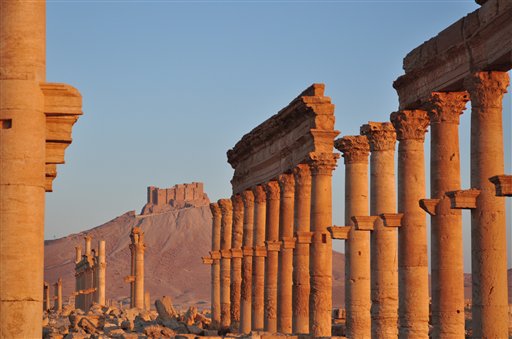
DAMASCUS, Syria— Islamic State militants destroyed three ancient tower tombs in the central city of Palmyra in the last few days, a Syrian government official said Friday.
Tower tombs, built on high grounds, are a unique feature of the Roman-era caravan city.
Maamoun Abdulkarim, head of the Antiquities and Museums Department in Damascus, said Friday the militants destroyed the tower tombs, including the Elahbel tower that dates back to A.D. 103, 10 days earlier. Abdulkarim said his information was based on witness accounts and satellite images provided by the Boston-based American Schools of Oriental Research.
In a report issued Thursday, the ASOR Syrian Heritage initiative said the IS group has destroyed seven tower tombs since the end of June over two phases. The last round of destruction occurred between August 27 and September 2, including the destruction of the Tower of Elahbel, the most prominent example of Palmyra’s distinct funerary monuments. The tower tombs of Iamliku and Atenaten were destroyed earlier.
“Collectively, the damage to these tombs is not confined to a single area within the Valley of the Tombs, but instead it is distributed throughout various locations, leaving some towers destroyed and others still standing,” the report said, showing a sequence of before-and-after satellite images. “The reasoning for this differentiation is unknown.”
The militants claim ancient relics and sites of worship promote idolatry. They have already destroyed modern-day Islamic cemeteries and shrines in the city.
On Sunday, the militants destroyed the two-millennia-old temple of Bel in the city, confirmed by U.N. satellite images. The smaller Temple of Baalshamin was also destroyed days before, and the IS group posted images of the damage.

The ASOR Syrian Heritage Initiative report, the most detailed on the recent damage caused by the IS group, confirmed the destruction of the smaller temple with satellite images. At the temple of Bel site, only the temple colonnades and the front gateway to the inner sanctuary were still standing, it said.
The U.N. Cultural Agency UNESCO called the destruction of Palmyra an “intolerable crime against civilization.”
Separately, the IS group posted pictures on social media apparently showing a town hall-style meeting in the central town of Qaryatain with local Christians.
The pictures showed the residents sitting in the meeting and some signing a contract forcing them to pay special taxes for non-Muslims. The contract, dated Sunday, also says they must abide by Islamic laws and regulations imposed by the group, refrain from building new churches and hide their religious symbols to be allowed to continue to live in Qaryatain.
Thousands of the town’s residents, a mixed population of Sunni Muslims and Christians, fled after Islamic State militants overran it earlier this month. The group abducted 230 residents, including dozens of Christians, from Qaryatain, which lies in the middle of a triangle formed by the cities of Homs, Palmyra and Damascus. Activists say some Christians were released, though the fate of the others was unknown.
Christians in the militant stronghold of Raqqa, which IS seized in 2014, were forced to pay special protection taxes as well. Associated Press, TVJ

RELATED STORIES
LOOK: Facing Islamic State threat, Iraq digitizes national library
In Islamic State war, like others, heritage always a target
Syrian official: Islamic State militants in Palmyra’s museum












































